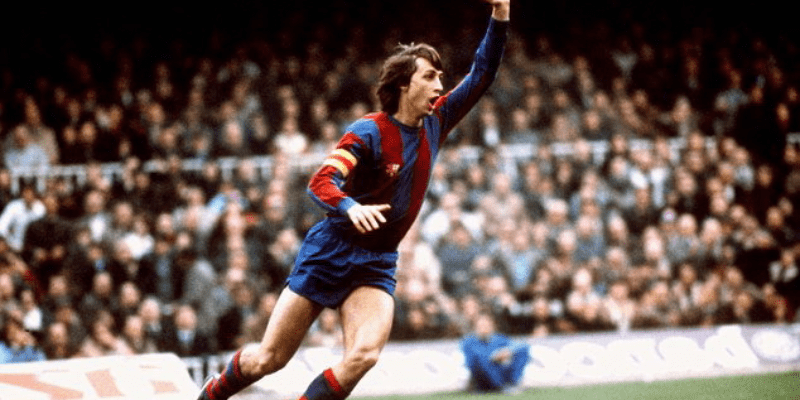When you type what did Johan Cruyff invent into a search bar, you might expect a single trophy, a new system, or a brand. The truth is more nuanced—and far more fascinating. In football lore, “invent” can stretch beyond a literal creation: it’s about influence, identity, innovation, and a legacy that reshaped the sport itself. Today, CantoKick takes you on a journey through Cruyff’s inventions: the trick everyone learns, the philosophy that powers giants, and the mindset that lives on in every pitch.
The Cruyff Turn: A Move That Defined an Era

Arguably the closest to a literal invention by Cruyff is the Cruyff Turn, a deceptively simple but devastating dribbling maneuver. In the 1974 World Cup match against Sweden, Cruyff feigned a pass, dragged the ball behind his planted foot, pivoted sharply 180 degrees, and accelerated away.
Though it’s debatable whether the move had truly never been done before, Cruyff’s version became iconic—so much so that the trick bears his name. The brilliance lies not in complexity, but in timing, simplicity, and the element of surprise. Even today, coaches teach it to youth players as a core skill.
Yet Cruyff did not merely invent a dribble—he used it as a symbol of a larger worldview: football must be fluid, intelligent, and expressive.
Total Football Reinvented

If the Cruyff Turn was his personal mark on the pitch, the bigger “invention” is philosophical: the modernization and living evolution of Total Football.
Origins and Evolution
Total Football, originally conceived and refined under coach Rinus Michels, emphasized positional interchange, team fluidity, spatial awareness, and collective intelligence. When Cruyff emerged, he breathed life into that system as its ultimate executor—playing in attack but dropping back, drifting wide, orchestrating the offense.
Cruyff’s “Invention” of Modern Total Football
What Cruyff “invented” was not Total Football itself, but a modern template where logic, finesse, and spatial geometry became as important as boots and speed. Under his influence:
- Teams prioritized possession, triangles, and movement off the ball over rigid structures.
- Players were asked to interpret roles rather than occupy fixed positions.
- At Barcelona, he laid the groundwork for a club identity centered around possession-based football and attacking expression.
In this sense, Cruyff invented a new language on the field—one where space, timing, geometry, and in-match adaptation became fundamental.
Tactical Innovations and Coaching Inventions

Beyond drills and philosophy, Cruyff introduced or popularized concrete tactical concepts and team-building principles.
Inverted Full-Backs & Positional Overloads
Cruyff experimented with defenders tucking inside and full-backs pushing high, creating overloads and numerical superiority in wide areas. He anticipated what modern coaches later refined into inverted full-back systems and positional play.
Three at the Back / Flexible Back Line
He often set up teams with three defenders—and demanded that midfielders and attackers reconfigure themselves fluidly. This flexibility undermined traditional formations and allowed teams to evolve shape mid-match.
Managing Intellect, Not Merely Strategy
Perhaps one of his most enduring “inventions” was the mindset shift: managers became less directors and more architects of ideas. He trusted players to think, interpret, and improvise. That cultural shift continues in elite teams today.
Off-Pitch Creations: Legacy That Lives On
Cruyff’s influence extended into architecture, institutions, and even infrastructure—suggesting his inventions were not limited to tactics alone.
Cruyff Courts
Through the Johan Cruyff Foundation, he helped launch Cruyff Courts: neighborhood-sized, artificial turf mini-pitches built around the world to give children access to safe spaces for street-style football.
Cruyff’s 14 Rules
In his autobiography, Cruyff laid out 14 fundamental rules—guiding principles for how to build a team, nurture youth, design training, and view the game itself. These “rules” are displayed at many Cruyff Courts worldwide.
Brand, Education, and Philosophy
He also launched a fashion/sportswear brand, founded the Johan Cruyff Institute, and infused his values—creativity, intelligence, integrity—into every project.
What Did Johan Cruyff Invent? A Summary
By now it should be clear: the question “what did Johan Cruyff invent” resists a single answer. Rather, Cruyff’s legacy is a constellation of inventions—drills, philosophies, tactics, institutions—woven into modern football’s DNA.
- As a near-literal invention, the Cruyff Turn is his most famous contribution to ball control and dribbling.
- As a philosophical inventor, he redefined Total Football, raising it.
- As a tactical innovator, he pioneered new formations, role fluidity, and trust-based coaching.
- Off the pitch, he built infrastructures and institutions that continue to shape youth football culture.
Why It Matters Today
Every time a youth academy coaches triangles, zones, pressing triggers, or positional rotation—they echo Cruyff. Every time a defender is pulled wide to free space, they mirror his spatial logic. Pep Guardiola refers to it plainly: Cruyff “painted the chapel.” Barca’s DNA, Ajax’s philosophy, Manchester City’s positional ideas—all carry echoes of Cruyff’s inventions. FA])
Final Thoughts
What did Johan Cruyff invent is a question that opens into the soul of modern football. He cannot be confined to a single trick or system—his invention was evolution itself. More than innovator, he was an architect.
At CantoKick, we believe remembering his dribbles is not enough—you need to understand how he transformed space, roles, systems, and mentality. Want to dive deeper into how Cruyff’s ideas shaped Guardiola’s Manchester City—or how young phenoms today practice the Cruyff Turn? Tell us what you’re curious about next.
Let Cruyff’s inventions guide your fandom—and your understanding of football’s beautiful revolution.



